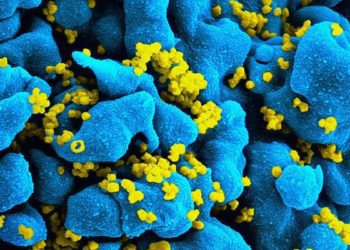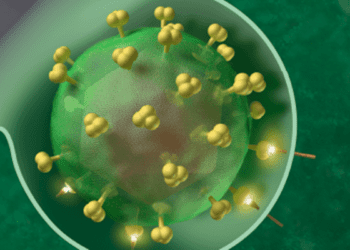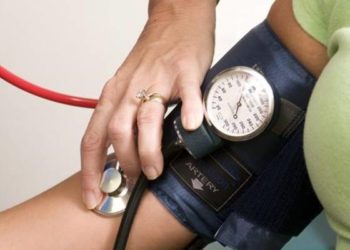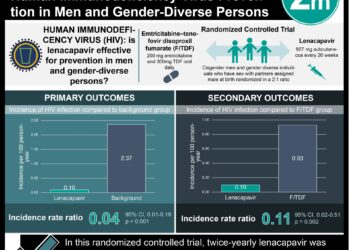2 Minute Medicine Rewind October 7-October 13, 2013
Image: PD
In this section, we will highlight the key high-impact studies, updates, and analyses published in medicine during the past week.
Efficacy Trial of a DNA/rAd5 HIV-1 Preventive Vaccine
The quest for a vaccine to prevent HIV has not been satisfactorily successful thus far – only one efficacy trial has shown a modest 31% reduction in HIV infection rates in Thailand. In this randomized, double-blinded, placebo-controlled trial, 2496 HIV-negative men and transgender women in the US with a history of unprotected sex with one or more male or male-to-female partners were randomized to DNA/rAd5 vaccine or placebo, with a primary outcome of HIV infection rate between 28 weeks and 24 months of the study period (week 28+ infection). The study was terminated early for futility. Despite the fact that the vaccine induced both cellular and humoral responses, week 28+ infection was diagnosed in 2.8% of the vaccine group vs 2.3% of the placebo group, with an estimated vaccine efficacy of -25% (p=0.44). There was also no difference in viral load between the two groups at 10-20 weeks after diagnosis.
There is mixed evidence for choosing colloid vs crystalloid solutions for fluid resuscitation in hypovolemic shock. In this randomized trial, 2857 ICU patients with hypovolemia were assigned to receive fluid resuscitation with crystalloids or colloids to study the effect on mortality at 28 days. Recruitment into the trial was stopped before the fixed sample size of 3010 patients was reached because there was no significant difference in mortality between the groups (359 vs 390 in colloids vs crystalloids group, p=0.26). Mortality at 90 days, however, was less in the colloids group compared to the crystalloids group (RR 0.92, p=0.03), and patients in the colloids group were less likely to require mechanical ventilation and vasopressors within the first 7 days (RR 0.3, p=0.01 and RR 0.3, p=0.04, respectively). There were no differences in the need for renal replacement therapy, organ failure, or length of hospital stay between the two groups. It is unclear to investigators exactly why 90-day mortality might be lower in patients receiving colloids.
With advances in blood banking, it has become more common for blood donor centers to provide separate blood components (red blood cells, platelets, plasma) to hospitals rather than whole blood (WB). Component (COMP) products are now also more frequently diluted with crystalloids, resulting in an increased occurrence of acute coagulopathy and other complications in the setting of mass transfusions for traumas. In this randomized trial, 107 trauma patients at a single institution were randomized to receive modified WB or component products (mWB or COMP group, respectively) to study the effect on 24-hour blood product use. Clinicians were blinded to treatment group until the seal of the cooler containing blood products was broken. There were no differences in 24-hour RBC (p=0.78), plasma (p=0.71), platelet use (p=0.41), or total transfusion volume (p=0.462) between the study groups. Secondary outcomes including 24-hour and 30-day mortality and transfusion-associated complications were not different between groups either. However, when patients with severe brain injury were excluded, the mWB group had significantly lower 24-hour RBC, plasma, and overall product use, and a trend towards longer median time to death (11.9 vs 1.9 hours for mWB vs COMP group, p=0.149).
There has been a huge push to rely more on evidence-based medicine in all medical fields, but publication bias may mean clinicians are not getting all of the information before making treatment decisions. In this retrospective study, investigators analyzed 101 unpublished clinical study reports (CSRs) of 16 drugs from between 1989 and 2010, and compared the information in the CSRs to published data for the same trials. All patient-relevant outcomes – mortality, clinical events, symptoms, quality of life, adverse events, serious adverse events, and withdrawal due to adverse events – were examined. Of the 101 CSRs, 86 had at least one published data source, and 15 had been unpublished. In addition, CSRs provided much more complete information about outcomes than journal publications and registry reports combined (86% vs 39%). Increasing availability of data from CSRs may allow physicians to make more informed decisions for their patients.
Risk of Major Adverse Cardiac Events Following Noncardiac Surgery in Patients With Coronary Stents
It is recommended to delay non-cardiac surgery for 1 year for drug-eluting stents (DES) and 6 weeks for bare-metal stents (BMS), though there is limited evidence supporting these guidelines. In this retrospective cohort study, researchers analyzed (1) the risk factors for major adverse cardiac events (MACE); (2) MACE rates relative to time between stent placement and surgery; and (3) the association between antiplatelet cessation and MACE in nearly 42,000 Veteran’s Affairs patients who underwent non-cardiac surgery within 2 years of receiving a cardiac stent. BMS were associated with a MACE rate of 5.1% vs 4.3% in patients with DES (p<0.001). Nonelective surgical presentation was the greatest predictor of MACE (OR 4.77, p<0.001), followed by occurrence of a myocardial infarction in the past 6 months (OR 2.63, p<0.001), and cardiac risk index. MACE occurred at a higher rate among surgeries closer to stent implantation, though patients with DES had lower odds of postoperative MACE than patients with BMS. Finally, there was no difference in MACE among those who continued or discontinued antiplatelet therapy prior to surgery (p=0.43).
By Kathleen Li and David Ouyang
© 2013 2minutemedicine.com. All rights reserved. No works may be reproduced without written consent from 2minutemedicine.com. Disclaimer: We present factual information directly from peer reviewed medical journals. No post should be construed as medical advice and is not intended as such by the authors or by 2minutemedicine.com. PLEASE SEE A HEALTHCARE PROVIDER IN YOUR AREA IF YOU SEEK MEDICAL ADVICE OF ANY SORT. Content is produced in accordance with fair use copyrights solely and strictly for the purpose of teaching, news and criticism. No benefit, monetary or otherwise, is realized by any participants or the owner of this domain.







